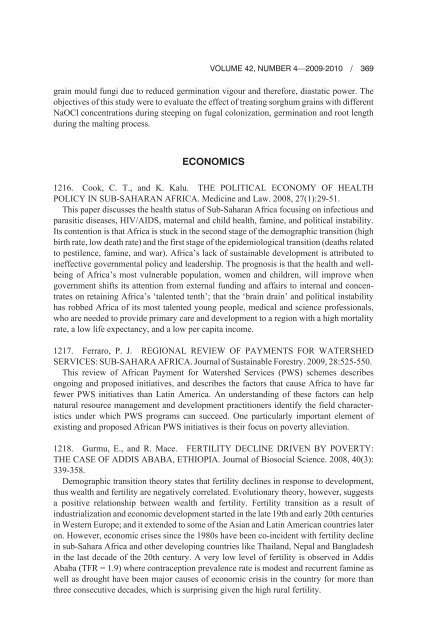A Current Bibliography on African Affairs - Baywood Publishing
A Current Bibliography on African Affairs - Baywood Publishing
A Current Bibliography on African Affairs - Baywood Publishing
You also want an ePaper? Increase the reach of your titles
YUMPU automatically turns print PDFs into web optimized ePapers that Google loves.
VOLUME 42, NUMBER 4—2009-2010 / 369<br />
grain mould fungi due to reduced germinati<strong>on</strong> vigour and therefore, diastatic power. The<br />
objectives of this study were to evaluate the effect of treating sorghum grains with different<br />
NaOCl c<strong>on</strong>centrati<strong>on</strong>s during steeping <strong>on</strong> fugal col<strong>on</strong>izati<strong>on</strong>, germinati<strong>on</strong> and root length<br />
during the malting process.<br />
ECONOMICS<br />
1216. Cook, C. T., and K. Kalu. THE POLITICAL ECONOMY OF HEALTH<br />
POLICY IN SUB-SAHARAN AFRICA. Medicine and Law. 2008, 27(1):29-51.<br />
This paper discusses the health status of Sub-Saharan Africa focusing <strong>on</strong> infectious and<br />
parasitic diseases, HIV/AIDS, maternal and child health, famine, and political instability.<br />
Its c<strong>on</strong>tenti<strong>on</strong> is that Africa is stuck in the sec<strong>on</strong>d stage of the demographic transiti<strong>on</strong> (high<br />
birth rate, low death rate) and the first stage of the epidemiological transiti<strong>on</strong> (deaths related<br />
to pestilence, famine, and war). Africa’s lack of sustainable development is attributed to<br />
ineffective governmental policy and leadership. The prognosis is that the health and wellbeing<br />
of Africa’s most vulnerable populati<strong>on</strong>, women and children, will improve when<br />
government shifts its attenti<strong>on</strong> from external funding and affairs to internal and c<strong>on</strong>centrates<br />
<strong>on</strong> retaining Africa’s ‘talented tenth’; that the ‘brain drain’ and political instability<br />
has robbed Africa of its most talented young people, medical and science professi<strong>on</strong>als,<br />
who are needed to provide primary care and development to a regi<strong>on</strong> with a high mortality<br />
rate, a low life expectancy, and a low per capita income.<br />
1217. Ferraro, P. J. REGIONAL REVIEW OF PAYMENTS FOR WATERSHED<br />
SERVICES: SUB-SAHARA AFRICA. Journal of Sustainable Forestry. 2009, 28:525-550.<br />
This review of <strong>African</strong> Payment for Watershed Services (PWS) schemes describes<br />
<strong>on</strong>going and proposed initiatives, and describes the factors that cause Africa to have far<br />
fewer PWS initiatives than Latin America. An understanding of these factors can help<br />
natural resource management and development practiti<strong>on</strong>ers identify the field characteristics<br />
under which PWS programs can succeed. One particularly important element of<br />
existing and proposed <strong>African</strong> PWS initiatives is their focus <strong>on</strong> poverty alleviati<strong>on</strong>.<br />
1218. Gurmu, E., and R. Mace. FERTILITY DECLINE DRIVEN BY POVERTY:<br />
THE CASE OF ADDIS ABABA, ETHIOPIA. Journal of Biosocial Science. 2008, 40(3):<br />
339-358.<br />
Demographic transiti<strong>on</strong> theory states that fertility declines in resp<strong>on</strong>se to development,<br />
thus wealth and fertility are negatively correlated. Evoluti<strong>on</strong>ary theory, however, suggests<br />
a positive relati<strong>on</strong>ship between wealth and fertility. Fertility transiti<strong>on</strong> as a result of<br />
industrializati<strong>on</strong> and ec<strong>on</strong>omic development started in the late 19th and early 20th centuries<br />
in Western Europe; and it extended to some of the Asian and Latin American countries later<br />
<strong>on</strong>. However, ec<strong>on</strong>omic crises since the 1980s have been co-incident with fertility decline<br />
in sub-Sahara Africa and other developing countries like Thailand, Nepal and Bangladesh<br />
in the last decade of the 20th century. A very low level of fertility is observed in Addis<br />
Ababa (TFR = 1.9) where c<strong>on</strong>tracepti<strong>on</strong> prevalence rate is modest and recurrent famine as<br />
well as drought have been major causes of ec<strong>on</strong>omic crisis in the country for more than<br />
three c<strong>on</strong>secutive decades, which is surprising given the high rural fertility.




